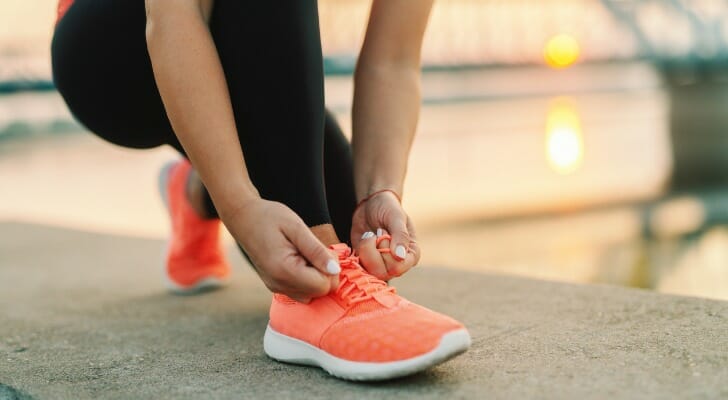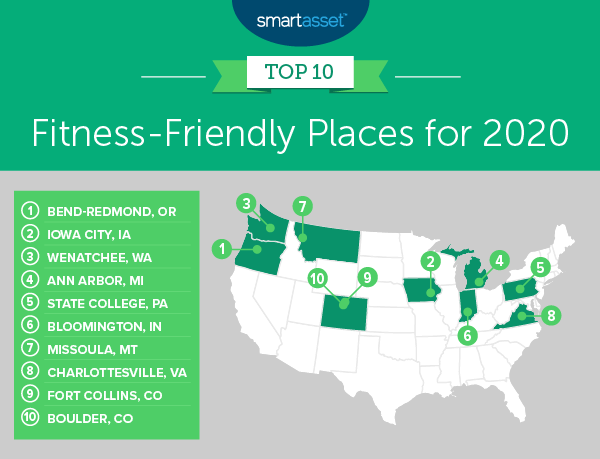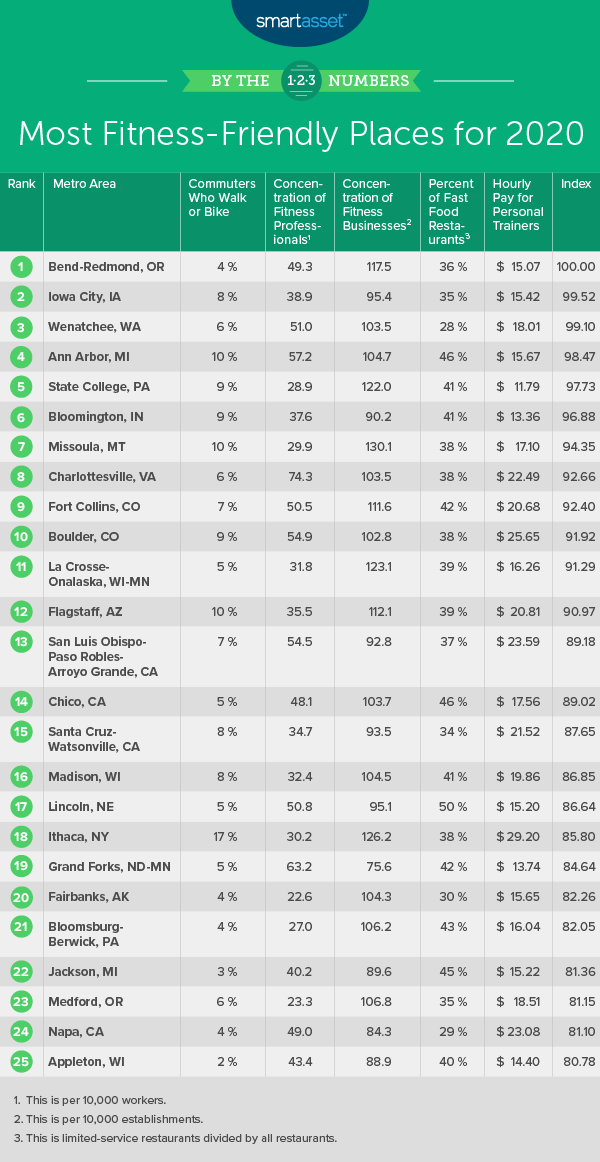
As we head into the new year, many of us are taking stock of what we accomplished in the past year and considering what goals we’d like to set for the coming one. Establishing a more consistent fitness routine may be on the list for some people, though it can sometimes burn more of our savings than our calories. That’s why SmartAsset examined the data to find the most affordable fitness-friendly places for the upcoming year.
To uncover the most fitness-friendly places for 2020, we considered data on 317 metro areas across five metrics: percentage of residents who walk or bike to work, fitness professionals per 10,000 workers, fitness establishments per 10,000 establishments, percentage of restaurants that are fast food and average hourly wage of personal trainers. For details on our data sources and how we put all the information together to create our final rankings, check out the Data and Methodology section below.
This is SmartAsset’s sixth annual study of the most fitness-friendly places in America. Read the previous version of the study here.
Key Findings
- Western and Midwestern states dominate the top 10. Five of the metro areas in our top 10 are in Western states: Oregon, Washington, Montana and Colorado. Three additional metro areas are in Midwestern states: Iowa, Michigan and Indiana. Furthermore, 11 of the top 25 metro areas are in Western states and nine of the top 25 metro areas are in Midwestern states. These locations all have a particularly high concentration of fitness facilities.
- Top fitness-friendly places have lots of walkers and bicyclists. A relatively cost-effective option to maintain regular physical activity is walking or bicycling to work. An average of about 2.9% of residents across all 317 metro areas we considered in this study travel this way to work. Across the top 10 metro areas, the rate is more than double that, at approximately 7.8%.

1. Bend-Redmond, OR
Bend-Redmond, Oregon ranks in the top 25% of the study across all five metrics that we considered. It has a top-10 rate for fitness establishments per 10,000 establishments, at approximately 117. Additionally, the cost of working out here may be less expensive than in other cities. With no direct data available on the direct cost to consumers for fitness services, we used the average hourly wage of personal trainers to indicate how costly training services may be for residents. This rate for Bend-Redmond is $15.07, the third-lowest across any metro area in our top 10.
2. Iowa City, IA
Iowa City, Iowa ranks within the top third of the study for all metrics. It does particularly well for the percentage of its residents who walk or bike to work, at 8.3%, the 11th-highest rate for this metric. Furthermore, support for those who seek guidance around their fitness regimen is widely available in Iowa City. There are more than 38 fitness professionals per 10,000 workers and more than 95 fitness establishments per 10,000 establishments in the metro area.
3. Wenatchee, WA
Though personal trainers in Wenatchee, Washington rank in the more expensive half of the study, this metro area ranks within the top 10% for all other metrics we considered. For those who consider eating fast food a detriment to their fitness regimen, only about 28% of restaurants in Wenatchee are fast food restaurants, the lowest percentage of any metro. Wenatchee also ranks within the top 10 for its high number of fitness professionals, at almost 51 per 10,000 workers.
4. Ann Arbor, MI
Ann Arbor, Michigan ranks in the top half of the study for all five metrics we considered. It does particularly well for its high percentage of residents who walk or bike to work – at 9.7%, the fifth-highest rate for this metric across all 317 metro areas we considered. This metro area also flexes its fitness-friendly attributes with approximately 57 fitness professionals per 10,000 workers and approximately 105 fitness establishments per 10,000 establishments, ranking fourth-highest and 18th-highest overall, respectively. Whether or not residents are blowing off steam at the gym, Ann Arbor also ranks as one of the least-stressed places in America.
5. State College, PA
State College, Pennsylvania ranks in the top third of the study for all five metrics we considered. It has top-10 rates for percentage of residents who walk or bike to work, number of fitness establishments per 10,000 establishments and average hourly wage of personal trainers. More than 8% of State College’s residents walk or bike to work, there are almost 122 fitness establishments per 10,000 establishments and the average hourly wage of personal trainers is less than $12.
6. Bloomington, IN
Bloomington, Indiana cracks the top 25% of the study for all five metrics we considered. It ranks eighth out of all 317 metro areas in the study for its relatively high percentage of residents who walk or bike to work, at approximately 9%. Furthermore, there are more than 37 fitness professionals per 10,000 workers and more than 90 fitness establishments per 10,000 establishments in Bloomington.
7. Missoula, MT
Missoula, Montana ranks in the top half of the study for all five metrics we considered. Although residents may have to pay a relatively high hourly rate for the services of a personal trainer here, there are many opportunities to seek out a gym or recreation center. Missoula has the highest rate of fitness establishments across all 317 metro areas for which we considered data, at approximately 130 fitness establishments per 10,000 establishments. Furthermore, Missoula has the fourth-highest percentage of residents who walk or bike to work and the highest rate for this metric in the top 10, at more than 10%.
8. Charlottesville, VA
Charlottesville, Virginia takes No. 8 in our study on the most fitness-friendly places in the country. It ranks in the top 15% of the study in four out of five metrics. It performs particularly well for its high number of fitness professionals, at approximately 74 per 10,000 workers. There are about 103 fitness establishments per 10,000 establishments in Charlottesville and the metro area ranks 46th overall for percentage of restaurants that are fast food, at less than 38%. Furthermore, 6.4% of residents there walk or bike to work. Residents here may be toning their muscles, but their already have finely built hearts: Charlottesville also ranks as one of the top places where Americans give the most to charity.
9. Fort Collins, CO
Despite having personal trainers who rank in the most expensive 25% of the study for average hourly wage, Fort Collins, Colorado ranks in the top 6% of study for three of our five metrics. The metro area performs particularly well in terms of its number of fitness professionals per 10,000 workers – ranking 11th out of 317 for this metric – and its number of fitness establishments per 10,000 establishments – ranking 12th out of 317. What’s more, approximately 7% of residents in Fort Collins walk or bike to work, the 19th-highest rate for this metric overall.
10. Boulder, CO
Boulder, Colorado rounds out the top 10 and ranks within the top 16% of the study for four out of the five metrics we considered. Despite having the highest hourly wages for a personal trainer in our top 10, at more than $25, there are ways that those in Boulder can improve their fitness in a more cost-effective capacity. The metro area does particularly well for its relatively high percentage of residents who walk or bike to work, at 9%, ranking sixth out of 317 for this metric. It performs the best for the category of number of fitness professionals per 10,000 workers, at more than 54, ranking fifth out of 317 for this metric.

Data and Methodology
To find the most fitness-friendly places in the country for 2020, we looked at data for 317 metro areas across the following five metrics:
- Percentage of residents who walk or bike to work. Data comes from the Census Bureau’s 2018 1-year American Community Survey.
- Concentration of fitness professionals. This is the number of fitness professionals per 10,000 workers. Our list of fitness professionals includes dietitians and nutritionists, recreational therapists, athletic trainers as well as fitness trainers and aerobics instructors. Data comes from the Bureau of Labor Statistics (BLS) Occupational Employment Statistics and is for May 2018.
- Concentration of fitness establishments. This is the number of fitness establishments per 10,000 establishments. Our list of fitness establishments includes sporting goods stores and fitness and recreational sports centers. Data comes from the Census Bureau’s 2017 Metro Area Business Patterns Survey.
- Concentration of fast food restaurants. This is the percentage of restaurants that are limited-service establishments. Data comes from the Census Bureau’s 2017 Metro Area Business Patterns Survey.
- Average hourly wage of personal trainers. Given the limited availability of direct data about the cost to consumers for personal training services, this metric acts as a proxy to indicate the relative affordability of hiring a personal trainer in a given metro area. Data comes from the BLS and is for May 2018.
First, we ranked each metro area in each metric. Then we found each place’s average ranking, giving all metrics a full weight except for concentration of fast food restaurants and average hourly wage of personal trainers, each of which we gave a half weight. Using this average ranking we created our final score. The metro area with the highest average ranking received a score of 100, and the metro area with the lowest average ranking received a score of 0.
Tips for Pumping up Your Savings
- Maintain a healthy budget. There are many ways to improve and maintain your health, but not all of them have to feel like a sucker punch to your bank account. Exercise healthy spending and saving habits by understanding what your budget looks like now and taking slow and steady steps to get yourself to your ideal situation.
- Create a disciplined regimen. Building your wealth, just like building your muscle, requires a set routine. If you want to sock more money away in your savings account, consider trying out the 50/30/20 budget plan.
- Get your finances into shape. If your overall financial picture looks like it’s a bit weak, you can get some help from a professional who can show you how to build and maintain the health of your money. Finding the right financial advisor that fits your needs doesn’t have to be hard. SmartAsset’s free tool matches you with financial advisors in your area in five minutes. If you’re ready to be matched with local advisors that will help you achieve your financial goals, get started now.
Questions about our study? Contact press@smartasset.com
Photo credit: ©iStock.com/dusanpetkovic